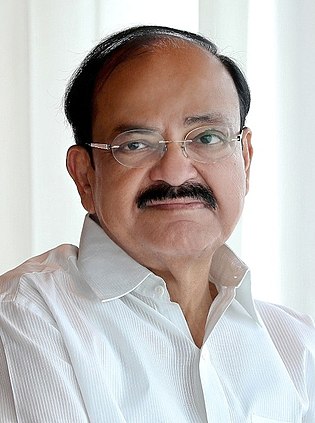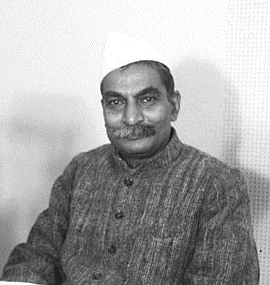
The Vice President of India is the second-highest constitutional office in India after the President. Article 63 of Indian Constitution states that "There shall be a Vice President of India." The Vice President acts as President in the absence of the president due to death, resignation, impeachment, or other situations.
The Indian National Lok Dal (INLD) is a political party in India, in the state of Haryana. INLD was founded in October 1996 as Haryana Lok Dal (Rashtriya) by Choudhary Devi Lal, who served as Deputy Prime Minister of India in the V.P. Singh's Cabinet and Chief Minister of Haryana twice. His son Om Prakash Chautala is the president.
India is a federation with a parliamentary system governed under the Constitution of India, which defines the power distribution between the union, or central, government and the states.

The Indian general election of 1951–52, held from 25 October 1951 to 21 February 1952, was the first election to the Lok Sabha since India became independent in August 1947. It was conducted under the provisions of the Indian Constitution, which was adopted on 26 November 1949. Elections to most of the state legislatures took place simultaneously.

The Indian general election of 1957, held from 24 February to 9 June, was the second election to the Lok Sabha, the lower house of the Parliament of India. They were held five years after the first general election, according to the provisions of the Constitution of India. Elections to many state legislatures were held simultaneously.

India held general elections to the 5th Lok Sabha in March 1971. This was the fifth election since independence in 1947. The 27 Indian states and union territories were represented by 518 constituencies, each with a single seat. Under the leadership of Indira Gandhi, the Indian National Congress (R) led a campaign which focussed on reducing poverty and won a landslide victory, overcoming a split in the party and regaining many of the seats lost in the previous election.

India held general elections to the 7th Lok Sabha in January 1980. The Janata Party alliance came into power after the elections to the 6th Lok Sabha held in 1977, riding the public anger against the Congress and the Emergency but its position was weak. The loose coalition barely held on to a majority with only 295 seats in the Lok Sabha and never quite had a firm grip on power.

General elections were held in India in 1989 to elect the members of the 9th Lok Sabha. V. P. Singh united the entire disparate spectrum of parties including regional parties such as the Telugu Desam Party, the Dravida Munnetra Kazhagam, and the Asom Gana Parishad, forming the National Front with N.T.Rama Rao as President and V. P. Singh as convenor with additional outside support from the Bharatiya Janata Party and Communist Party of India (Marxist) led Left front they defeated Rajiv Gandhi's Congress (I) in the 1989 parliamentary elections.
The Election Commission of India held indirect 10th presidential elections of India on 16 July 1992. Shankar Dayal Sharma with 675,864 votes won over his nearest rival George Gilbert Swell who got 346,485 votes.

The Election Commission of India held indirect 9th presidential elections of India on July 1987. R. Venkataraman with 740,148 votes won over his nearest rival V. R. Krishna Iyer who got 281,550 votes.

The Election Commission of India held indirect 8th presidential elections of India on July 1982. Zail Singh with 754,113 votes won over his nearest rival Hans Raj Khanna who got 282,685 votes. Zail Singh was the first Sikh to be President of India, and along with former Prime Minister of India Manmohan Singh, were the only two Sikhs, to hold one of the highest national power in India.

The Election Commission of India held indirect 5th presidential elections of India on August 1969. Varahagiri Venkata Giri with 420,077 votes won in a runoff election over his rival Neelam Sanjeeva Reddy who got 405,427 votes.
The Election Commission of India held the indirect 4th presidential elections of India on May 6, 1967. Dr. Zakir Husain, with 471,244 votes, won the presidency over his rival Koka Subba Rao, who garnered 363,971 votes.
The Election Commission of India held indirect 3rd presidential elections of India on May 7, 1962. Dr. Sarvepalli Radhakrishnan with 553,067 votes won the presidency over his rivals Chowdhry Hari Ram who got 6,341 votes and Yamuna Prasad Trisulia who got 3,537 votes.

The Election Commission of India held the first presidential elections of India on May 2, 1952. Dr. Rajendra Prasad won his first election with 507,400 votes (83.81%) over his nearest rival K. T. Shah who got 92,827 votes (15.3%).

The 14th indirect presidential election, in order to elect the 13th president, was held in India on 19 July 2012. The last date for filing nominations was 30 June, whereas the votes would be counted on 22 July. The two leading candidates for the presidency were former Finance Minister Pranab Mukherjee from West Bengal and former Speaker of the Lok Sabha Purno Agitok Sangma from Meghalaya.
Tridib Chaudhuri (1911–1997) was an Indian politician and Indian independence activist. He was a leader of the Revolutionary Socialist Party and a member of Lok Sabha from Baharampur in West Bengal in India. He was the joint opposition candidate for Indian presidential election, 1974. He was member of Lok Sabha from 1952 to 1984 and a member of Rajya Sabha from 1987 to 1997 until his death. He had participated in Goa Liberation Movement. He was one of the founders of the RSP.

The 2019 Indian general election is scheduled to be held in seven phases from 11 April to 19 May 2019 to constitute the 17th Lok Sabha. The counting of votes will be conducted on 23 May, and on the same day the results will be declared.

The Election Commission of India is an autonomous constitutional authority responsible for administering election processes in India. The body administers elections to the Lok Sabha and Rajya Sabha and state Legislative Assemblies and Legislative Council in India, and the offices of the President and Vice President in the country. The Election Commission operates under the authority of Constitution per Article 324, and subsequently enacted Representation of the People Act. The commission has the powers under the Constitution, to act in an appropriate manner when the enacted laws make insufficient provisions to deal with a given situation in the conduct of an election. Being a constitutional authority, Election Commission is amongst the few institutions which function with both autonomy and freedom, along with the country’s higher judiciary, the Union Public Service Commission and the Comptroller and Auditor General of India.
The elections to the next Vice-President of India, were held on 5 August 2017. The announcement was made by the Election Commission of India.

















